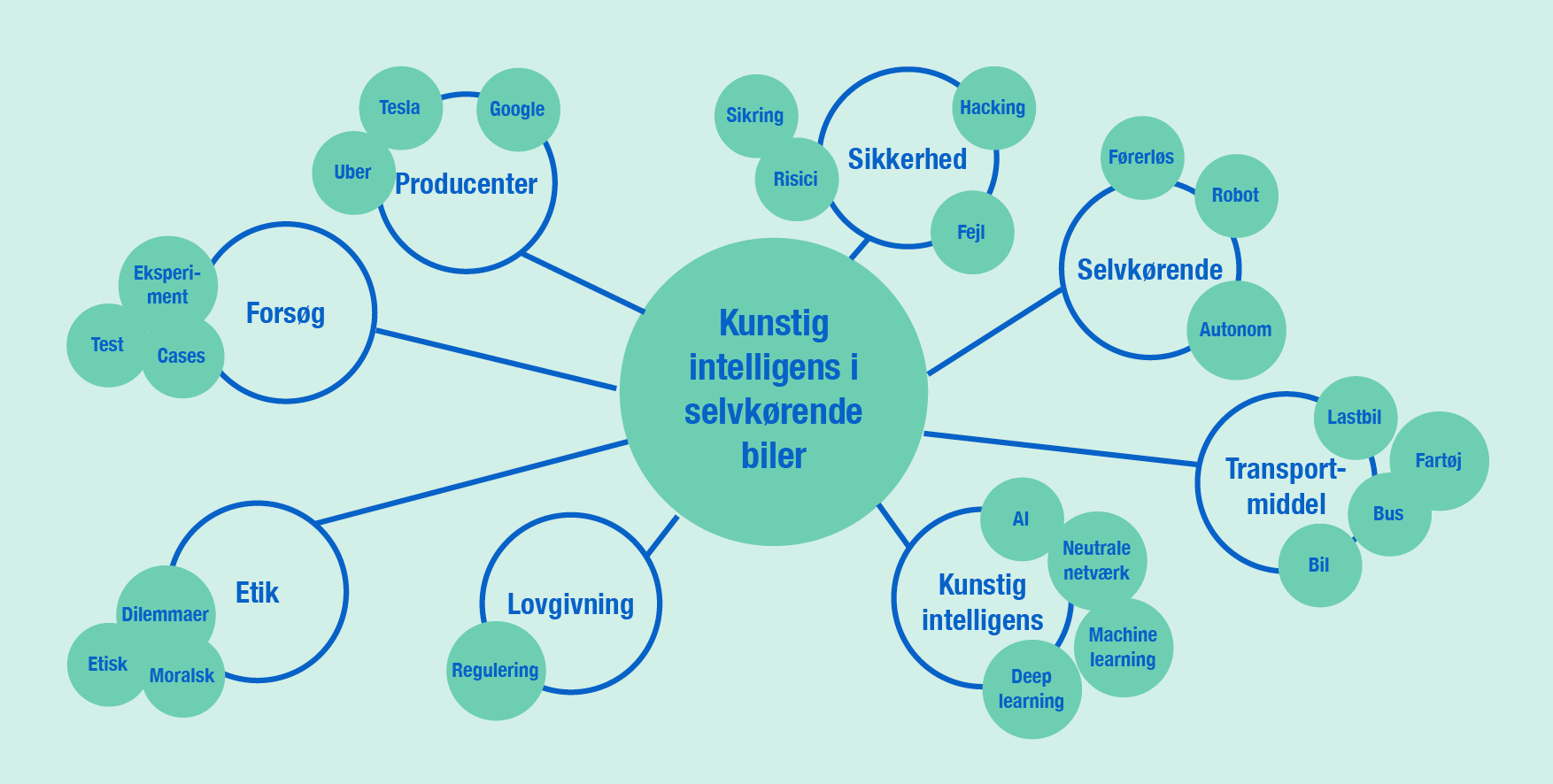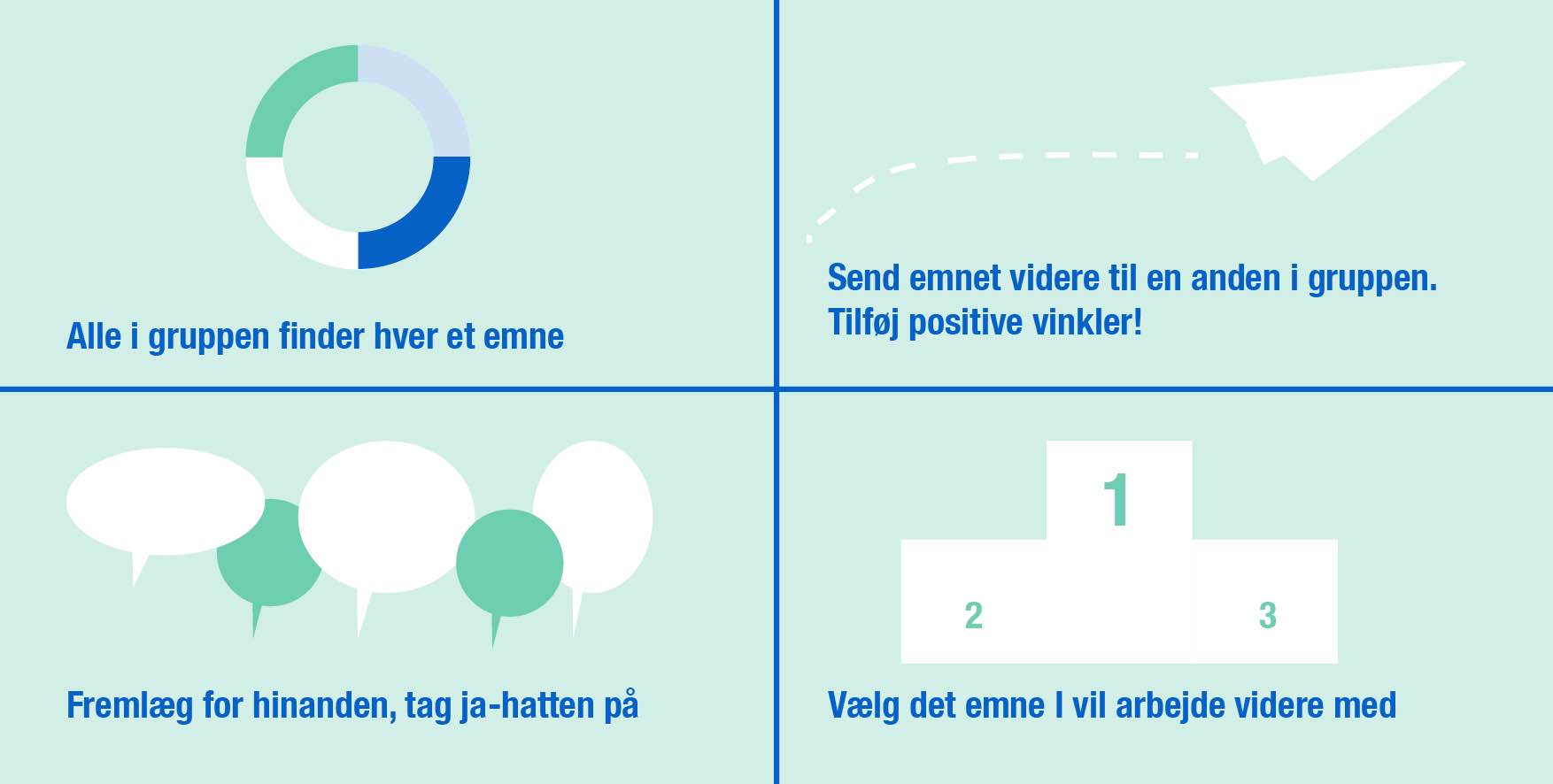Assignment writing
How to write a good assignment
You probably know the feeling. You have spent two weeks working on a major assignment, and still there is not a single letter on your computer screen. Do not worry! You are not the only one! Assignment writing puts even the most diligent students to the test.
On the next pages you can find information about the aspects of assignment writing that may cause frustration and which you should know about before you embark on a major written assignment.
The starting point is problem-oriented assignment writing, i.e. an assignment where you must solve or investigate something and use the knowledge acquired in your studies.
Genre requirements
What are the characteristics of a study assignment?
When you start writing a study assignment, it is important that you are aware of the genre requirements. What is the ideal, and what is the best way to present the content?
It is crucial that all the points and arguments are substantiated by relevant theories and methods. You write within a profession, and your claims must therefore be professionally substantiated.
Your assignment must be transparent, and your reader must never be in doubt as to the purpose of your assignment. In other words, what exactly are you going to explore, why is it important and how will you do it?
It is also essential that you work systematically and methodically, so that everything you write can be verified and followed by the reader. Furthermore, you must demonstrate knowledge of the latest within your profession and use this knowledge in your assignment.
The assignment must be written in grammatically correct, precise and professional English. Finally, all the formal requirements (page number, layout, etc.) must be met.
Consider the genre requirements as a guideline that can help you get a grasp on your written assignment, both linguistically and methodically. It is all about clear and precise language, the use of the latest knowledge as well as a well-defined purpose.
Find your subject
How do I circle in on what I want to explore?

When embarking on a major project and writing independent assignments, it is crucial that you choose a subject of interest to you. It ensures your motivation for writing the assignment and increases your curiosity for the subject matter.
If you are finding it difficult to find an obvious subject, it might be useful to search for inspiration in anything from non-fictional books, academic articles, newspapers, websites, your study group/network, study assignments etc. Here, you'll often find some pointers to interesting subjects and new trends within your profession.
Then, you need to circle in on the subject. Start by doing some quick and broad searches for the subject online. Early on in the process it's ok to use Google, while supplying with searching the library catalogue and some professional journals. Find out what's currently happening within the subject field. What could be interesting to delve further into? Where is there something at stake? Are there emerging trends? And which point of view and delimitation can you apply to your subject?
It's important to state that the process from finding your subject to creating a problem formulation is the same no matter the profession you're writing within. The only thing changing is the content - that is, what you put into your problem formulation.
-
Choose a subject - Example 1
If you, for example, find the subject of influencers interesting, you should zone in on something specific about influencers that you wish to further explore and emphasize. Consider where your specific interest lies? Are there any special problems - something that puzzles you - or a limited nuance of the influencer phenomena that tickles your fancy? Maybe you're preoccupied with the extent to which young women are affected by influencers and how they may have an impact on their consumption and their values. This way, you move from an overall subject about influencers and social media into a deeper, more concrete and limited subject matter you can cover within the time period you have to write your assignment.
Subject: Social media and influencers
Focus: Young women, consumption and influencers
Problem formulation: To what extent are 20-30 year old women living in Copenhagen affected by influencers and their product promotion in social media? And how does it influence their consumption behaviour and values? -
Choose a subject - Example 2
Subject: Green roofs
Focus: Green roofs, climate adaptation and moisture
Problem formulation: How do you keep a green roof construction efficient as a sustainable urban drainage system, while avoiding moisture damage?
Tools and models
There are several methods that can help you choose a subject and make it more concrete, so that you'll end up with a problem formulation. It's a matter of personal taste what works for you, but give them a try and find your favourite.
-
Keep a record of your ideas
It can be quite efficient to keep a record of the subject ideas that comes to mind during your studies.
You might have stumbled upon an interesting article, had an engaging discussion in your study group or worked on a specific project. Record your thoughts and reflections as they come to you, making it easier to come up with a subject later, while keeping up to date professionally.Method: Keep a record of your ideas
When: Throughout the semester
Materials: Note book or digitally
Purpose: Build a catalogue of interesting subjects -
Speed writing
Use speed writing to zone in on your chosen subject. Speed writing means applying writing as a tool to reflect upon your subject matter.
The idea is that you'll write down all your thoughts on the subject: What do you already know about the subject, what interests you about it, which technical concepts exists within the subject field, and can you identify engaging problem areas within it?
It's important that you set a certain amount of time aside to write and refrain from taking breaks while writing. Write freely without critical thinking. Do not stop to consider terminology, spelling and the like. If you get stuck, write that down; "Now I'm stuck", and describe the feeling it gives, while attempting to slowly get back to the subject.
Speed writing is a good method to get a handle on your thoughts and start the process of putting words to paper. The method may seem a bit uncomfortable and strange at first, but it's a fruitful way of getting off to a good start.
Method: Speed writing
Time: 5-10 minutes
Materials: Paper/pencil (You can write digitally, if you prefer that)
Purpose: Closing in on a problem formulation (can also be applied throughout the writing process) -
Make a mind map
If you've landed on a general subject, but feeling uncertain about how you'll circle in on a concrete topic, it might be a good idea to make a mind map. It will give you a visual map of your thoughts, unfold the subject(s) for you and let you link the different terms and concepts to each other. You can also apply illustrations, drawings and color codes to your map if you are a visually orientated person.
 Method: Mind map
Method: Mind map
Time: 5-10 minutes
Materials: Paper/Pencil (You can do it digitally, if you prefer that)
Purpose: Closing in on your subject and establish connections between subtopics -
Relay your subject
If you are a study group trying to find a subject for a group assignment, it might be useful to start off with a brainstorming exercise. Try for instance the Relay model.

Get together and spend 5-10 minutes with individually coming up with a subject. Write your idea on a piece of paper while adding some descriptive keywords to it. Then, pass the paper along to another person in the group, which then continues to work on the subject for another 5-10 minutes.
It is only allowed to add positive aspects - supplementary ideas or perspectives. It's crucial that everyone participating in the exercise has a positive outlook to it and sees the potential in all ideas. Hereafter, you present your ideas to each other, preferably including the new perspectives/thoughts you've added. Again, it is important having a positive outlook and discussion about the ideas. When all presentations are done, the group selects two ideas that they'll work with together - until the final decision is made on which subject to go with.
Depending on how aligned you are on the two remaining ideas, you can decide to extend the work on these until the decision is made, but make sure to always focus on the opportunities of the subjects, rather than the potential pitfalls.
Method: Relay model
Time: + 1 hour
Materials: Paper, markers, post-its
Purpose: Brainstorm, idea development and concretization of subject in groups
Don't forget that the subject should reflect where your focus lies within your chosen professional field, and where you wish to go in your professional life after you graduate. The assignment is your opportunity to delve into a specific subject matter and applying yourself there. You are not writing the assignment for the sake of KEA - but for yourself, which can be nice to remind oneself of sometimes!
Problem formulation
How do I write a good problem formulation?

A good problem formulation not only helps you meet the requirements of the study programme, it also helps you structure your assignments. In the problem formulation, you ask the question(s) you want to answer in the conclusion, which will have an influence on the way the assignment is structured. It is therefore essential that there is a direct link between the problem formulation, the structure of the assignment and the conclusion.
It is your problem formulation that determines everything you write in your assignment. It guides you during the writing process, and it helps you establish a common thread throughout your assignment.
Your problem formulation must always be based on a specific relevant problem, and it must be possible to resolve the problem based on the theories and methods of your study programme. The problem formulation should preferably be delimited. Rather than try to cover a large area, it should allow for an in-depth study of a particular subject.
When you write the problem formulation, it is a good idea to keep in mind the academic levels that must be present in a study assignment: the explanatory, analysing and evaluative level. An easy way to do this is to use question words such as what (explanatory level), why (analysing level) and how (evaluative level) directly in your problem formulation.
Problem formulation in levels
Problem formulation
What is it that makes it difficult for students to write an assignment? (explanatory level) Why is it difficult? (analysing level) And how can you help them in the process? (evaluative level)
When your problem formulation ensures the presence of all three levels in the assignment, it is easier for you to meet the professional requirements of a study assignment. It is not necessary to use the exact words what, why and how, but the three levels must be implied in the questions.
Problem formulation with key and sub-questions
Your problem formulation may consist of only one key question followed by a few sub-questions that may help you answer the main question.
Problem formulation:
How to ensure that the building industry in Denmark meets the UN's new climate goals? (main question)
Sub-questions:
What are the UN’s climate goals and what is the intention behind them? (Explanatory)
How may the goals change the practice of the building industry? (Analysing and evaluative)
Why may they be difficult to implement? (Evaluative)
Remember that the wording of the problem formulation can vary from study programme to study programme and from semester to semester. Therefore, it is always important that you ask your teacher/counsellor for advice.
Taxonomic levels
What does it mean to describe, analyze and discuss?
When, as a student, you are about to write a problem oriented assignment, where you are to come up with a solution to a problem, you should consider the different levels inherent in any written assignment:
A descriptive, an analyzing and an evaluating level.
Descriptive level
At the descriptive level you describe and explain the theories and methods you wish to apply to your assignment. Here, you'll also prove your knowledge of the theories and aspects of your profession, and show that you are able to present them to others.
Analyzing level
At the analyzing level, you'll apply the theories and methods you have described earlier, in order to analyze your problem area and weigh the different solutions against each other. As a student, it is at the analysis level that you'll be able to shine, showing with a critical point of view how to attack the problem formulation.
Evaluative level
At the evaluative level, you'll come up with a solution to your problem formulation. Taking its starting point in your analysis, while including the theory you've used, the methods you've applied and possibly the empirical evidence you've found, you'll find a solution. Not all assignments require an evaluative level. Check this with your teacher or your study programme.
When do you apply the different levels?
Generally speaking, you'll likely utilize the descriptive level in your theory and method sections, the analyzing level in your analysis, and the evaluative level in your discussion section.
But it's important to be aware that there may be overlaps between the three levels, and you might sometimes both describe and analyze in the same assignment section.
The essential point is that you make sure to use all levels at some point in your problem-oriented assignment - proving that you are able to both describe the theories of your profession, analyze different problem areas and evaluate which solution is the best for your specific problem.
Outline and structure
The writing process - which parts should be part of my assignment?

There are many ways to attack the task of writing an assignment. Some plan ahead in detail, while others write feverishly the night before deadline. You know what works best for you, but it might be a good idea to reflect on how you can improve your writing process.
One way of gaining some clarity, is to make an outline. A well deliberated outline or disposition can give you an overview and prevent any frustrations in your writing process. To be precise, it's all about putting to paper the elements you know in advance that you want to include in your assignment.
First off, it is wise to decide on your problem formulation before making the outline, as it will help you consider which parts and chapters you need to include in your assignment. To be precise, you have to define what you need to know to be able to answer the questions in your problem formulation - and in which order to answer them.
Try to gain an overview of the chapters/sections you know will be part of the assignment, and which theories and methods they should build upon. Look at the disposition as a table of contents or list of ingredients, which you slowly expand with subtopics. Alternatively, you can apply a mind map to help visualize the project and the various sections.
Even though you might choose to not follow the disposition to the letter, the process of making it in itself can be quite productive for your writing.This is especially true if you are writing together with others in a study group.
Assignment structure
How do I structure my assignment? Which sections should follow each other and how? And what information should each section include? The structure of the assignment has always been a challenging task, and you might find that there are differences between the various professions on how to approach it.
It is therefore a good idea to consult with your teacher or find answers to your questions in your study programme. Here, you'll find information on the structure of the assignment - which sections should be included and what are the formal requirements.
A typical assignment structure may look like this:
- Front page and title
- Table of contents
- Introduction / problem formulation
- Explanation of theory and method, etc.
- Analysis of the defined problem by means of the theories and methods described
- Discussion
- Conclusion
- Bibliography
- Appendices
-
Introduction
In the introduction, you present the topic of the assignment and your approach to it. The introduction should awaken a professional curiosity for the subject in the reader, and provide an outline of what the assignment is about. Furthermore, the introduction should naturally lead towards your problem formulation, and, if possible, show the delimitations concerning parts of the subject that might not be relevant for the assignment.
-
The problem formulation
The question(s) you wish to answer in your assignment is presented in the problem formulation. The problem formulation is created from a professional issue or a problem area within the profession which you want to explore. It dictates everything you put into your assignment and is the basis upon which you investigate and analyse, while also being the questions you answer in the conclusion.
-
Theory and method
In the theory and method section, you account for the theories you will make use of and the methods you will apply. Furthermore, you also describe any surveys you will carry out - questionnaires, focus groups, interviews etc.
-
Analysis
The analytical part is a key part of any major assignment. Whereas descriptive information includes a representation of already known knowledge, the analytical part is where you, in principle, produce new knowledge. Here, you collect, process, analyse and interpret data based on the theories and methods you have chosen for the assignment.
-
Discussion
In the discussion it is important that you manage to assess and discuss the results that you have come up with in your analysis. A good discussion will be critical and reflect on the results of the analysis and the methods used, as well as comment on strengths and weaknesses of your choice of methods. In addition, a discussion will also include the way the results of the analysis should be understood and whether they may be used in other or broader contexts. It is also possible to begin the discussion in the analysis section. Note that there are differences between the professions and study programmes on this.
-
Conclusion
In the conclusion, you answer the question(s) of your problem formulation. And that is it! It is a repetition of the key points of your assignment, and a direct answer to your problem formulation. Therefore, you are not allowed to introduce new things or discussions in the conclusion.
Writer's block
Having trouble getting started?

It's completely normal to experience periods of writer's block when you're starting a major study assignment. Fortunately, there are ways to move forward:
- Start by figuring out why you're having trouble getting started:
- Don't know what to write?
- Lost your overview?
- Having difficulty expressing yourself well? Perhaps you're too critical?
-
Feeling tired/lacking energy?
-
Depending on the cause, you can consider the following strategies:
-
Use the speed writing method and let your thoughts flow without self-control.
- Create a mind map to get a better overview, then try to make a plan for your further writing.
- Speak out load; it can actually help to formulate something verbally before writing it down. And remember, it doesn't have to be perfect. You can always edit it later.
- Take a well-deserved break - go for a walk, watch a movie, or something similar. And remember, everything will be fine!
-

